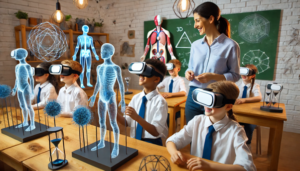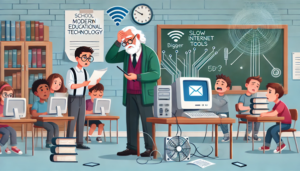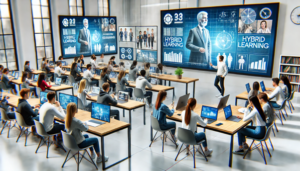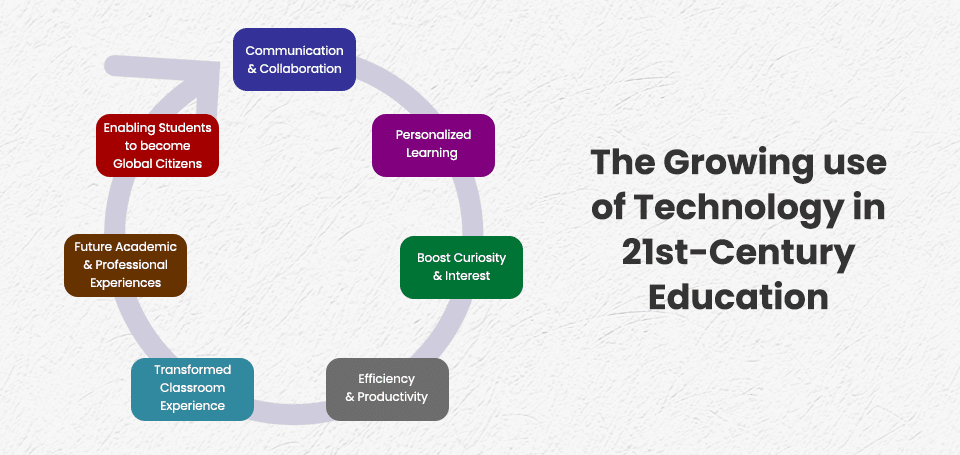The Growing Use of Technology in 21st Century
Technology has revolutionized 21st-century education, making learning more engaging, accessible, and effective. The use of technology in education is an essential tool for improving student outcomes, fostering collaboration, and preparing learners for the modern world. This article explores the importance of technology in education, its key benefits, challenges, and how schools like Epistemo are successfully integrating it.
Importance of Technology in 21st-Century Education:
The importance of technology in education cannot be overstated. It enables students to access information quickly, fosters interactive learning, and enhances the overall educational experience. Education in the 21st century is no longer confined to textbooks and classrooms. Digital tools have expanded learning beyond physical boundaries, making it more flexible and inclusive.
Key Benefits of 21st-Century Technology in Education:
1.Enhanced Communication and Collaboration:
The use of technology in education allows teachers and students to collaborate in real-time. Digital platforms such as virtual classrooms, discussion forums, and project-sharing tools enable students to work together, improving problem-solving and teamwork skills. Schools adopting strategies like cooperative learning have reported significant improvements in student collaboration and engagement.
Also Read: The Role of Cooperative Learning in Developing Social Skills
For example, at Epistemo, students recently collaborated on a history project using Google Classroom and Padlet. They researched ancient civilizations, shared findings on digital boards, and co-created multimedia presentations—enhancing both teamwork and digital literacy.
2.Personalized Learning Opportunities:
With 21st-century education, students can learn at their own pace through online courses, educational apps, and interactive e-books. Personalized learning adapts to different learning styles, improving knowledge retention and understanding.
At Epistemo, student Aanya struggled with math in a traditional setting. However, with adaptive learning software, she accessed customized lessons, received instant feedback, and tracked her progress. Within months, her confidence and performance improved significantly, showcasing the power of technology-driven personalized education.
3.Engaging and Interactive Learning:

Interactive content, including Virtual Reality (VR), Augmented Reality (AR), videos, and gamified learning, fosters curiosity and deeper understanding. As traditional textbooks evolve, digital learning resources are becoming a crucial part of modern education.
Also Read: The Future of Textbooks in the Digital Age
At Epistemo, VR field trips through Google Expeditions bring history and science lessons to life, allowing students to virtually visit ancient civilizations or explore the human body in 3D. AR apps like QuiverVision make abstract concepts more tangible and exciting.
4.Improved Teacher Efficiency and Productivity:
Technology in 21st-century pedagogy shifts learning from a teacher-centered model to a student-driven approach. Schools implementing child-centric and activity-based learning have found students more engaged and motivated in their educational journey.
5.A Student-Centered Learning Experience:
Technology in 21st-century pedagogy shifts learning from a teacher-centered model to a student-driven approach. Digital tools empower students to take charge of their education, explore topics independently, and develop critical thinking skills.
6.Differentiated Instruction for Diverse Learning Needs:
Classrooms consist of students with varying abilities. Technology for education enables educators to tailor lessons based on individual needs, ensuring each student receives personalized support. 21st-century technology in education facilitates differentiated instruction, making learning more effective for all students.
7.Preparation for Future Careers:
To be career-ready, students need to develop strong digital literacy, problem-solving, and coding skills. These competencies are crucial in today’s world, where future-ready skills define professional success.
Also Read: Skills for Future: Preparing Students for Tomorrow
8.Enabling Students to Become Global Citizens:
With the influx of technology in the 21st century, students can connect with peers worldwide, fostering cultural exchange and global awareness. Virtual classrooms and online collaboration tools help break down geographical barriers, promoting diversity and inclusivity in education.
Challenges in Implementing Technology in Education:

Despite its benefits, integrating technology in the 21st century presents challenges:
1.Infrastructure Issues:
Many schools worldwide, especially in developing regions, struggle with inadequate technological infrastructure. Poor internet connectivity, lack of modern hardware, and insufficient technical support hinder the seamless integration of digital learning. Countries like India, Brazil, and several African nations face significant digital divide issues, where rural schools lack basic connectivity while urban institutions progress rapidly.
2.Teacher Training Gaps
Even with access to technology, many educators lack the necessary skills to use digital tools effectively. Professional development programs are essential, but not all institutions have the resources to provide ongoing training. Countries such as Finland and Singapore have successfully addressed this by implementing mandatory digital training programs for teachers.
3.Student Distractions
While technology enhances learning, excessive or unstructured screen time can lead to distractions. Social media, gaming, and non-educational content can divert students' attention from their studies. To combat this, schools in Japan and Germany implement structured screen-time policies, ensuring that digital learning remains productive and balanced.
4.Cybersecurity Concerns
While technology opens doors for global learning, cybersecurity threats pose serious risks. Educators and parents must ensure that students practice safe social media habits and secure their digital presence.
Also Read: How to Use Social Media for Academic and Personal Growth Safely
How Epistemo Integrates 21st-Century Technology?

Epistemo Vikas Leadership School stands at the forefront of innovation, integrating digital tools into everyday learning. With a focus on student success, Epistemo aligns with modern education approaches to ensure learners are well-prepared for the future.
Also Read: An Introduction to Epistemo Schools: Redefining Modern Education
Students at Epistemo use cutting-edge educational technology tools for attending classes, completing assignments, and collaborating with peers. With hybrid learning models and digital resources, Epistemo prepares students for success in an increasingly technology-driven world.
Measurable Impact of Technology at Epistemo:
Since integrating technology into our curriculum, we have observed significant improvements in student participation, academic performance, and overall engagement. Digital tools have transformed the learning experience, making education more interactive and student-focused.
Conclusion:
The importance of technology in education is undeniable. It enhances collaboration, personalizes learning, improves teacher efficiency, and prepares students for the future. However, successful integration requires addressing challenges like infrastructure, training, and cybersecurity.
At Epistemo, we are committed to leveraging 21st-century technology in education to empower students with the skills and knowledge needed for a dynamic world.
Frequently Asked Questions (FAQ):
1. What is the use of technology in education?
Technology in education enhances learning by making it more interactive, accessible, and engaging. It enables virtual classrooms, personalized learning experiences, and access to vast digital resources, ensuring students receive a dynamic 21st-century education.
2. What is the role of technology in modern education?
The role of technology in modern education is to facilitate digital learning, improve communication, and enhance collaboration. It supports innovative teaching strategies, helps students develop critical thinking skills, and prepares them for technology-driven careers.
3. What are the contributions of technology in education?
Technology contributes to education by transforming traditional learning into a more student-centered, interactive, and adaptive experience. It enables differentiated instruction, fosters engagement through tools like Virtual Reality (VR) and Augmented Reality (AR), and enhances teacher productivity.
4. How useful is technology for learning?
Technology is highly useful for learning as it provides students with personalized, engaging, and flexible educational experiences. It enables adaptive learning, instant feedback, and access to global knowledge, making education more effective and inclusive.
5. Why is technology important in 21st-century education?
Technology is crucial in 21st-century education as it prepares students for the digital world, enhances collaboration, and improves learning outcomes. It supports online learning, digital literacy, and interactive pedagogy, ensuring students gain essential future-ready skills.
6. What is the role of technology in education in today’s world?
In today’s education system, technology plays a fundamental role in enabling remote learning, improving student engagement, and making education more inclusive. Digital tools like online platforms, smart classrooms, and AI-driven learning systems help streamline teaching and learning.
7. How does technology affect teaching and learning?
Technology positively impacts teaching and learning by enhancing lesson delivery, providing real-time assessments, and making learning more immersive. It enables educators to use digital tools for differentiated instruction, while students benefit from interactive and self-paced learning experiences.
8. What is the contribution of technology in education?
The contribution of technology in education is vast, from increasing student participation and collaboration to improving accessibility and efficiency. It enables blended learning models, fosters global connectivity, and equips students with the necessary skills for the modern workforce.


